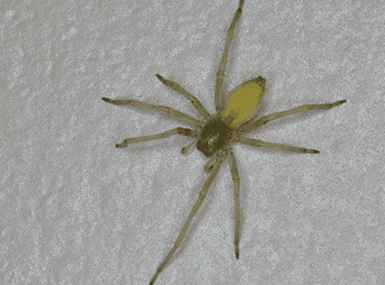We can’t count a number of times that we answer the phone and someone in our Illinois, Iowa or our Quad Cities service areas, is looking for help to identify a mysterious yellow spider that has shown up in their home. Generally speaking, we are happy to report that most of the time the offending arachnid is harmless enough; nevertheless, it is an uncomfortable houseguest to have around. Once in a while, though, we get that call that tells us that the spider in questions may be small, but its bite can pack quite a punch.
The yellow sac spider is one of the smaller species of spider that you can encounter, only averaging around .5 inches in length. It is easily recognizable by its yellowish to light green coloring and the dark mark near the abdomen. This spider generally lives outside in wood piles, yard debris, and in trees, hiding out in silk tubes during the day, and making their way out at night to hunt. Yellow sac spiders typically eat other spiders and garden pests.
The yellow sac spider mates in early summer, and the female spider will generally look for a protected place under cover to lay eggs. Frequently, that place is inside a building where the eggs will be safe. The female spider will deposit up to 5 sacs - each containing more than a few dozen eggs. Before long, a homeowner might just find themselves with an unexpected yellow sac spider infestation.
As with most nocturnal insects, it might take a while before someone notices one inside their house. Frequently when they do, it is because one has found its way into the sheets of the bed or into clothing and shoes. The moment one of these yellow sac spiders feels threatened, they will bite to defend themselves. For most that have experienced a bite from a yellow sac spider, that means serious pain in the area as well as redness and swelling. It can also sometimes mean a fever, cramps, and nausea. Though it is extremely rare, the yellow sac spider bite might also lead to ulcers in the area of the bite that require immediate medical attention.
When dealing with a potentially dangerous species of spider, it is imperative that you do not try to remove them on your own. There is no way for the untrained person to be able to tell where the spiders are hiding or how many there might be. Using over-the-counter products in your home is not only a potential danger, but you never know how many yellow sac spiders you may have missed. Our residential pest control program offers all of the solutions that you need to keep your home spider free. Contact us today, and before you know it, a highly-trained member of our team will be on their way to determine the type of spiders living in the home and the most effective way to remove them as quickly as possible.

